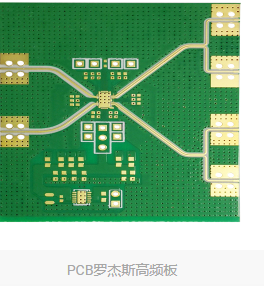Classification and selection of PCB Rogers high-frequency board plates
PCB Rogers high-frequency board refers to a special circuit board with a higher electromagnetic frequency. It is used for high-frequency (frequency greater than 300MHZ or wavelength less than 1 meter) and microwave (frequency greater than 3GHZ or wavelength less than 0.1 meter). The material copper clad board uses part of the process of the ordinary rigid circuit board manufacturing method or the circuit board produced by the special processing method. Generally speaking, PCB Rogers high frequency board can be defined as a circuit board with a frequency above 1GHz. The substrate material needs to have excellent electrical properties, good chemical stability, and the loss on the substrate with the increase of the power signal frequency is very small, so the importance of the PCB Rogers high-frequency board is highlighted.
What are the classifications of PCB Rogers high-frequency board plates
1. End ceramic filled with thermosetting material
Processing method
The processing process is similar to epoxy/glass woven cloth (FR4), except that the sheet is relatively brittle and easy to break. When drilling and gongs, the life of the drill tip and gong knife will be reduced by 20%.
2. PTFE (polytetrafluoroethylene) material
Processing method
1. Cutting: The protective film must be kept to prevent scratches and creasing.
2. Drilling:
(1) Use a brand new drill (standard 130), one by one is the best, the pressure of the presser foot is 40psi;
(2) The aluminum sheet is the cover plate, and then the PTFE plate is tightened with a 1mm melamine backing plate;
(3) After drilling, use an air gun to blow out the dust in the hole;
(4) Use the most stabe driling rig and drilling parameters (basically, the smaller the hole, the faster the drilling speed, the smaller the Chipload, the lower the return speed).

3. Hole treatment
Plasma treatment or sodium naphthalene activation treatment is conducive to hole metallization
4. PTH sinking copper
(1) After the micro-etching (with the 20 micro-inch control of the micro-etching rate), pull the plate into the plate from the de-oiling cylinder in the PTH;
(2) If necessary, pass the second PTH, and only need to start the board from the expected cylinder.
5. Solder mask
(1) Pre-treatment: Use acidic plate washing, not mechanical grinding plate;
(2) Baking plate (90 degree Celsius, 30min) after pretreatment, brush green oil to solidify;
(3) Three-stage baking: one section is 80 degree Celsius, 100 degree Celsius, 150 degree Celsius, and the time is 30min each (if you find oil on the substrate surface, you can rework: wash off the green oil and reactivate it).
6. PCB Rogers high frequency board gong board
Lay white paper on the circuit surface of the PTFE board, and clamp it up and down with the FR-4 base plate or phenolic base plate with a thickness of 1.0MM etched to remove copper.
How to choose PCB Rogers high-frequency board
The choice of PCB circuit board materials must strike a balance between meeting design requirements, mass production, and cost. Simply put, design requirements include electrical and structural reliability. Usually this board problem is more important when designing very high-speed PCB boards (frequency greater than GHz).
1. Cost factors
It depends on the price sensitivity of the product, whether it is a consumer product, or a communication, medical, industrial, or military application;
2. Manufacturability
For example, how many times the pressing performance, temperature performance, etc., resistance to CAF / heat resistance and mechanical toughness (adhesion) (good reliability), fire rating;
3. Timely availability of materials
Many high-frequency boards have a very long procurement cycle, even 2-3 months; in addition to the conventional high-frequency board RO4350 in stock, many PCB high-frequency boards need to be provided by customers. Therefore, PCB Rogers high-frequency board needs to communicate well with the manufacturer in advance and prepare the materials as soon as possible;
4. Various properties that match the product
Low loss, stable Dk/Df parameters, low dispersion, small variation coefficient with frequency and environment, small tolerance of material thickness and glue content (good impedance control), if the trace is long, consider low-roughness copper foil. In addition, the design of high-speed circuits requires simulation in the early stage, and the simulation results are the reference standard for the design.
5. Applicability of laws and regulations, etc.
It must be integrated with the environmental regulations of different countries and meet the requirements of RoHS and halogen-free.
Among the above factors, the operating speed of high-speed digital circuits is the main factor considered in PCB selection. The higher the circuit speed, the smaller the selected PCBDf value. Boards with medium and low loss will be suitable for 10Gb/s digital circuits; plates with lower loss will be suitable for 25Gb/s digital circuits; plates with ultra-low loss will be suitable for faster high-speed digital circuits, and the rate can be 50Gb/s or higher.